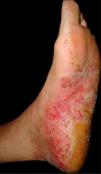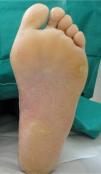Palmar-plantar pustulosis is a chronic disorder characterized by sterile pustules and scaly erythematous lesions on the palms and soles. Its etiology is unknown and its relationship to psoriasis remains controversial; some authors consider it to be a variant of psoriasis, whereas others consider it to be a distinct condition.1 It is more common in women, with a peak incidence between 30 and 40 years of age. Its close association with smoking is well known, and this has recently led some authors to suggest that it could be an autoimmune disease induced by tobacco.2 It is also associated with thyroid disease, skeletal lesions, diabetes, and celiac disease. This disorder is difficult to manage, not only because of its lack of response to different treatments, but also because it has a strong impact on patients’ quality of life. There is no specific treatment. Therapeutic options include topical treatment with steroids and retinoids, systemic treatment with cyclosporin, retinoids, methotrexate, and colchicine, and oral and topical phototherapy,3 but the response is usually poor and combination treatment is frequently needed. There is scientific evidence of the efficacy and safety of biological agents in patients with psoriasis vulgaris.4 Furthermore, these drugs have recently achieved good responses in patients with other forms of psoriasis, such as palmar-plantar psoriasis. López-Estebaranz5 and Kasche6 described 2 patients with palmar-plantar pustular psoriasis resistant to combination treatment which improved after treatment with etanercept. There have also been reports of isolated cases of palmar-plantar psoriasis with good results after treatment with ustekinumab.7 Ustekinumab is a human monoclonal antibody that binds with high specificity and affinity to the p40 subunit of interleukin (IL) 12 and IL-23, and blocks the differentiation of helper T (TH) cells into TH1 and TH17 cells, decreasing the release of IL-17. It is indicated for the treatment of moderate or severe psoriasis in adults with no response, contraindications, or intolerance to other systemic therapies. References to the use of ustekinumab for the treatment of palmar-plantar pustulosis are rare, although Gerdes et al. described its use in 4 patients with palmar-plantar pustulosis with a satisfactory response in 2 of them.8 It has been shown that there is an increase in some inflammatory mediators such as IL-17F and IL-8, which induce neutrophil activation and accumulation, thus promoting the formation of pustular lesions.9,10 It therefore appears reasonable to assume that ustekinumab could be a good therapeutic option since it reduces the levels of both mediators.
We present the case of a 64-year-old woman with a 14-year history of palmar-plantar pustulosis. On examination she had scaly erythematous pustular lesions on both the palms and soles (Fig. 1) that made walking very difficult and caused significant pain. For 5 years the patient had been treated with different drugs such as ciclosporin, acitretin, or methotrexate, sometimes in combination with topical treatments such as corticosteroids and keratolytics, without obtaining complete remission of the lesions. Psoralen-UV-A sessions were also conducted, including sessions in which this therapeutic option was combined with other treatments such as acitretin and ciclosporin; these led to improvement in the palmar lesions but not in the plantar lesions. In 2007, efalizumab therapy was started; the patient remained clear of lesions for 2 years until treatment was discontinued after the drug was withdrawn from the market. Within 2 months there was a recurrence of the lesions on the palms and soles, and treatment was therefore started with etanercept at a dose of 50mg/wk. Given the lack of response to etanercept after 5 months of treatment, it was substituted by adalimumab, which was continued for 6 months without achieving satisfactory results. In 2010, treatment was begun with ustekinumab at a dose of 45mg every 12 weeks. After 2 doses, there was obvious improvement in the lesions with almost complete clearance, leaving only residual lesions (Fig. 2). At the time of the last follow-up, 8 months after beginning ustekinumab therapy, the patient remained free of lesions. Whenever this indication was not included in the summary of product characteristics of the drugs employed, we applied for compassionate use and obtained informed consent from the patient.
Thus, in our case, ustekinumab proved to be an effective therapeutic option that led to a significant improvement in the lesions and increased the patient's quality of life. Although our data are insufficient to assess its long-term effect, we believe that ustekinumab therapy could be of value in cases of palmar-plantar pustulosis resistant to other treatments. Further research into the mechanism by which the drug achieves the observed improvement is warranted, as well as studies with more patients to either confirm or reject the usefulness of ustekinumab in this problematic disease.
Please cite this article as: de Unamuno-Bustos B, et al. Tratamiento de la pustulosis palmo-plantar con ustekinumab. Actas Dermosifiliogr. 2011;102:833-834.










